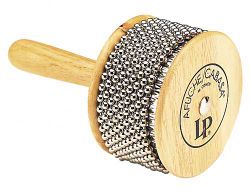Difference between revisions of "Afuche"
| (One intermediate revision by one other user not shown) | |||
| Line 1: | Line 1: | ||
| − | [[Image: | + | [[Image:afuche.jpg|right|thumb|250px|Afuche]] |
== Etymology and Alternative Spellings == | == Etymology and Alternative Spellings == | ||
Port. ''[[Afuche]]''<br/> | Port. ''[[Afuche]]''<br/> | ||
| Line 11: | Line 11: | ||
== History == | == History == | ||
| − | Although closely related to the African [[Shekere]], the ''afuche'' is an ingenious substitution for the native Latin American instrument known as the [[Cabasa]]. The ''afuche'' was ceated by | + | Although closely related to the African [[Shekere]], the ''afuche'' is an ingenious substitution for the native Latin American instrument known as the [[Cabasa]]. The ''afuche'' was ceated by Latin Percussion founder Martin Cohen in the latter half of the 20th century. Because of the close relations of these instruments, composers and performers alike often use the terms ''afuche'' and ''cabasa'' interchangeably. However, it is important to the integrity of the music that the diligent performer determine the composers intentions. For more on this see [[Cabasa]]. <ref>Blades, James. Percussion Instruments and Their History. Wesport: The Bold Strummer, Ltd., 2005, pp.450. (accessed January 27, 2013) </ref> |
== Technique == | == Technique == | ||
Latest revision as of 12:54, 1 May 2015
Etymology and Alternative Spellings
Port. Afuche
Construction
Metallic cabasas are generally referred to as afuche. The instrument consists of several loops of metallic beads that move against a hollow, metallic cylinder. [1]
History
Although closely related to the African Shekere, the afuche is an ingenious substitution for the native Latin American instrument known as the Cabasa. The afuche was ceated by Latin Percussion founder Martin Cohen in the latter half of the 20th century. Because of the close relations of these instruments, composers and performers alike often use the terms afuche and cabasa interchangeably. However, it is important to the integrity of the music that the diligent performer determine the composers intentions. For more on this see Cabasa. [2]
Technique
The non-dominant hand rests on the loops of metallic beads while the other hand grabs the wooden/plastic handle and rotates the instrument back and forth in a clock-wise, counter clock-wise motion.
Manufacturers
Retailers
Steve Weiss Music
Percussion Source
Lone Star Percussion
See Also
References
